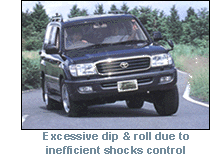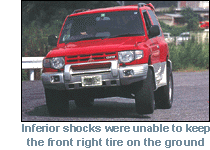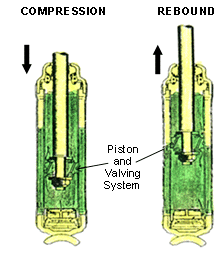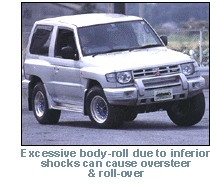 |
|

|
|
Our
Products |
|
|
|
|
|
 |
|
|
|
|
|
Various
Makes & Functions of Shock
The
following are extracts from the articles published
in the American and Australian 4x4 magazines.
|
|
SHOCKING NEWS I
Your
4WD sways into corners, plowing and rocking, then
stumbling with oversteer, Those OEM shocks barely
manageable when new, now seem lifeless, leaving
your 4WD oscillating and rebounding violently.
Speed bumps jar your jaw so hard that you need to
replace cracked fillings.
|
|
BOUNCE,
JOUNCE AND SHOCK DAMPING |
|
|
|
|
|
|
|
When
a vehicle moves over irregular terrain the springs
that are supporting the body and chassis develop a
rapid oscillating motion. Undampened spring
oscillations could turn your stomach inside out.
Shock absorbers serve several roles. The shocks
must quickly stop the oscillation of the 4WDís
springs, a good set of shock absorbers provide
driver and occupant comfort as the vehicle
performs over a wide variety of terrain.
Additionally, the shock absorbers help your truck
stabilize as the weight distribution and gravity
changes dramatically as you steer into corners.
Weight applies hard to the outside springs and
eases up considerably on the inboard set. The
shock absorbers help moderate the extremes of
weight loading and movement.
A final job for good shock absorbers is to keep
the tires on the ground. Especially with
coil-sprung 4x4s, clawing for traction in loose,
bouncy terrain can cause the wheels to actually
leave the ground. The result is loss of traction,
vehicle control and overall safety. Shock
absorbers help control wheelhop by rapidly
restoring vehicle stability.
|


|
|
|
|
|
The
traditional OEM (Original Equipment) shock for
most 4WDs, however, has been a twin-tube hydraulic
type. Functional and less expensive to produce,
hydraulic shocks can serve a wide range of uses.
The drawback is the quality and tuning level of
most OEM standard shocks which have a shorter life
span than upgrade shocks, especially when put to
hard work. The primary purpose of shock absorber
is to tame spring oscillations, the kinetic force
that grows to extremes on rough washboard roads at
speed. In the taming of this kinetic energy, the
dampening action of shock absorber generates
tremendous heat. Heat and rapid piston movement
create foaming. Low-cost OEM standard shocks
seldom resist the fast cycling, heat build-up and
fluid foaming that lead to shock absorber
"fade".
|
|
WHEN
SHOCK PERFORMANCE FADES AWAY |
|
|
|
|
|
Fade
does occur when a hydraulic shock absorber extends
and collapses at a high rate of speed. Engineers
note that as shock absorber moves beyond 150
cycles per minute, hydraulic oil begins to mix
with air within the shock absorber. This aerates
the oil. Foamy aerated oil, with a much lower
viscosity, moves through the shock absorberís
valving system at a higher rate of speed Under
these conditions, the shocks absorberís load
rating deteriorates, and at the extreme, the
shocks simply fail to dampen the spring
oscillations. Common symptoms of fade are a harsh
ride, poor stability on corners and wheelhop.
|
|
FLUID
CONTROL AND VALVING |
|
|
|
|
|
 Spring
rates aim at a reasonable ride, smooth
suspension and proper load carrying capacity.
The shock absorbersí job is to sense chassis
loads and spring travel, then regulate fluid
damping to control jounce and rebound. Spring
rates aim at a reasonable ride, smooth
suspension and proper load carrying capacity.
The shock absorbersí job is to sense chassis
loads and spring travel, then regulate fluid
damping to control jounce and rebound.
Twin-tube hydraulic shock absorbers, whether gas
cell or not, operate similarly. Some shock
valving is as basic as a rod moving a sealed
piston, with a series of sized holes to control
fluid movement. More sophisticated shocks use
precise, spring-balanced metering systems to
adjust pressure and fluid flow.
When wheels hit bumps and rise, the shock
absorber allows fluid to move in a precise
volume through the metering orifice(s).
Engineers can create specific damping effects
for each rate of spring travel. Valves also
allow fluid to move rapidly upon suspension
impact in situations like the bone-jarring holes
that emerge from nowhere.
These same valves close during rebound, forcing
large amounts of fluid to squeeze through
metering orifices. This establishes a greater
damping action on rebound than bounce.
Valving ratios and fluid flow is a science. We
depend on the research, shock bench studies and
skid pad tests of manufacturers to create the
right damping rates for each and individual
4WDs. As a rule, shocks with a 40 percent bounce
to 60 percent rebound ratio work well in most
multipurpose light 4WD environments.
Before getting hung up on ratios, however, keep
in mind that spring rate varies and other
factors may alter your 4WDís needs. Shock
absorbers are not all the same, and thereís
nothing "universal" when matching
shocks to your 4WDís chassis but getting a
complete set of shocks and springs produced by a
same reputable suspension company with matching
rates for a specific usage is the best bet.
Before they design a shock absorber, engineers
consider the spring or torsion bar design, wheel
travel, intended terrain, vehicle weight
distribution, load capacity, sprung and unsprung
mass, plus the velocity that shock fluid must
travel in inches per second. Even then, testing
in the field will serve as the real world stress
test.
Oversize wheels and tires, stiffer lift kit
springs and other chassis requirements increase
the load on shock absorbers. Factory engineers
and many aftermarket multiple shock kit builders
spend hours working with CAD drawings and skid
pad tests to confirm optimal shock absorber
design and mounting angles. Although many show
trucks give the impression that more is better,
the real incentive for multiple gangs of shock
focuses on proper valving rates and useful
mounting angles.
|
|
|
|
This absorber can only work
in an upright and vertical position. The valving
and necessary air pocket within a hydraulic
shock absorber require that the shock rod face
upward. In an upside-down position, a hydraulic
shock absorberís piston would need to move
about three inches before fluid compression
could take place.
For non-ordinary or horizontal shock absorber
mounting, foam cell shocks solve the air
pocket problem. If your custom 4WD requires
horizontal or upside-down shock positioning,
consider a foam cell shock design.
Examples of non gas hydraulic shocks are :
|
|
TWIN
TUBE LOW PRESSURE GAS-CHARGED SHOCKS |
|
|
|
|
|
An
offshoot of the standard twintube hydraulic shock
absorber is the twin-tube low-pressure gas-charged
shock. These shocks counter the air pocket
weaknesses of standard hydraulic shocks.
Instead of handling fluid displacement with an air
pocket, low-pressure gas shock designs replace
that air with an inertgas, typically nitrogen.
Charge pressures range from 60-200 psi. The main
goal with gas-charged shocks is to eliminate
aeration of fluid, the common cause of fade.
The down side with gas-charged shocks is
"pump up". Like any other shock absorber
design, heat builds up with fast cycling, and the
gas pressure increases. Foaming, however, is far
less likely with these shocks than with standard
hydraulic types. Undesirable stiffness and erratic
damping can occur when heat raises gas pressures.
These shocks are more suitable for 4WDs with leaf
springs suspension as due to the friction in
between the many leaves they do not work the
shocks as hard than the coil sprung 4WDs.
An example of low-pressure gas-charged shocks is :
Tough Dog Nitrogen Gas Shock.
|
|
FOAM
AND CELLULAR GAS SHOCKS |
|
|
|
|
|
Other
improvements over standard hydraulic shocks are
the foam cell and gas cell designs. These shocks
counter the troublesome air pocket built into
standard shocks.
|
|
|
|
Is
an easy way to prevent air foaming. The nylon foam
cell material which has tiny closed cells that
contain bubbles of gas cannot mix with the oil. As
a result, air that might otherwise cause foaming
is no longer a threat.
Because the air pocket is now isolated from the
oil, odd mounting angles are not a problem. These
shocks work well in all positions, and air-free,
non-foaming fluid action can provide precise
tuning.
Foam cell shock absorbers offer better valve
tuning for a wider range of operating conditions.
Fade is far less likely to occur. Unlike
gas-charged shocks, pump up is non-existent.
Although fluid viscosity does change under severe
conditions, these shocks, stand a better chance of
delivering long and consistent performance. These
shocks are especially good for 4WDs with coil
springs suspension which demand very heavy duty
shocks.
An example of foam cell shock is : Tough Dog
Heavy Duty Foam Cell Shock.
|
|
SEALED
PLASTIC CELLULAR GAS SHOCK |
|
|
|
|
|
Often
called "nitrogen cell" designs, offer
another improvement over the standard hydraulic
shock. Compressible gas-filled plastic cell occupy
the space normally allotted to air pockets. The
cell prevents air from mixing with oil, which
reduces the risk of fluid aeration (foaming) that
causes shock fade.
Unlike foam cell material, the non-permeable gas
bag must stay sealed and intact. When buying
cellular shocks, always consider quality. We have
cut out a versions of these shocks absorbers and
found the plastic bag split open and completely
out of place.
Once on your truck, the only other test for a
plastic cell shock is whether they still perform
effectively. When shock fade occurs over washboard
roads, chances are good that the nitrogen or
gas-filled plastic bag has ruptured.
Examples of plastic cellular gas shocks are 1) Rancho
Shock 2) Explorer Pro-Comp Cellular Gas
Shock.
|
|
SINGLE
MONO TUBE HIGH-PRESSURE GAS SHOCKS |
|
|
|
|
|
French
scientist/engineer Dr. De Carbon patented the high
gas pressure operated shock absorber. Unlike
low-pressure gas twin-tube shocks, which still
rely on fluid for damping, these shocks operate at
200-350 psi.
Charged with nitrogen gas, these shocks work
simply, with few moving parts. Valving is at each
side of the piston, and there is no second tube
for the oil reservoir. Full oil volume is right
there, ready to work at all times. As the oil gas
are highly pressurized, these shocks can mount at
any angle.
Unfortunately, a serious off-roader would quickly
discover the mono-tube shockís weaknesses. By
design, the necessary long shock tube creates
mounting problems and a high likelihood that the
shock rod will bottom out during full suspension
travel.
These shocks would be an unlikely fit for typical
OEM shock mounts. If they did fit, the user would
constantly fear damage to the single tube. Many
4WDs face the perils of off-pavement rock, brush
and limbs. Unlike with twin-tube shocks, where the
outer tube is simply an oil reservoir, a minor
ding to the mono-shock housing could destroy the
piston seals or even cause piston seizure.
Pump-up can reach the crisis stage in this
high-pressure gas shock absorber. Heat, the number
one product of shock absorber action, causes
nitrogen gases to expand. Pressure levels could
become severe enough to prevent suspension travel
or cause shock and mount breakage. High-pressure
gas mono-tube shocks are popular among European
sports car owners than with rough and tumble off-roaders
that require good wheels articulation only the
twin-tube shocks can offer.
Examples of the single tube high-pressure gas
shocks are :
|
|
|
|
|
SHOCKING NEWS II
Shock
is not only contributing to the comfort level but
also the handling, control and safety of your 4WD
and NOT ALL SHOCKS are made equal in quality !!
The
thrill of the rattle, bump, knock and roll of a
roller-coaster is loved by many but not when they
happen on your 4WD. These are inherent in most
4WDs with cheap and inefficient suspension system
especially the shock absorbers.
|
|
THE
IMPORTANT ROLE OF SHOCK ABSORBER |
|
|
|
|
|
 The
shock absorber is very often ignored whilst we
emphasized a lot on a vehicle external and
internal looks and the engine performance and etc
when we are looking to buy a new 4WD or when we
are upgrading our 4WD. The
shock absorber is very often ignored whilst we
emphasized a lot on a vehicle external and
internal looks and the engine performance and etc
when we are looking to buy a new 4WD or when we
are upgrading our 4WD.
Although often overlooked, the humble shock
absorber plays a very important role in keeping
the wheel on the ground for best possible road
holding, to control the bounce, roll and dip of
the vehicle body and at the same time to absorb
whatever shocks (as the name says) generated from
the surface the wheel is moving over.
|
|
DIFFERENT
DEGREE OF SHOCK DAMPING FOR
LEAVES, COILS AND AIRBAGS
SUSPENSION |
|
|
|
|
|
The
purpose of the springs fitted to a suspension
system is to dissipate the sudden shock
transmitted to the vehicle and finally to its
passengers when a wheel hits a bump. If it is a
small bump it will create a small shock but if it
is a big bump it will create a spine thumping
force that can throw you off your seat. But the
after effect of fitting the spring is that the
vehicle will tends to bounce and bounce and also
sway and dip rather than one bounce for each bump
when the vehicle moves over an undulating surface,
it is just like a loose ball rolling down a
staircase. This is when the shock absorbers or
dampers as you may call them come into play to
control its enthusiasm.
 The
switch to coil spring suspension on many 4WDs has
greatly increased the importance of the shock
absorber in the overall scale of things. The
reason being that a leaf spring has a certain
amount of self damping effect thanks to the
friction created between the many leaves of the
leaf spring stack. As a leaf spring flexes, the
many leaves stacked together rub against each
other and restrict the number of oscillation of
the entire spring. Thus, it imposes less burden on
the shock to control the oscillation. Whereas, the
coil spring does not have the same friction. So,
it would continue to bounce, sway and oscillate up
and down long after the vehicle has gone over the
bump that causes its first bounce. The newer 4WD
now with air bag suspension has even demanded a
new breed of super heavy duty shock to control the
bounce and sway. A typical air bag suspension
oscillates many times more than a conventional
leaf spring suspension. So unless you donít mind
your vehicle body bouncing up and down swaying
from side to side or dipping to the front or to
the rear whenever you do a braking or acceleration
you are going to need really good and efficient
shock damping. The
switch to coil spring suspension on many 4WDs has
greatly increased the importance of the shock
absorber in the overall scale of things. The
reason being that a leaf spring has a certain
amount of self damping effect thanks to the
friction created between the many leaves of the
leaf spring stack. As a leaf spring flexes, the
many leaves stacked together rub against each
other and restrict the number of oscillation of
the entire spring. Thus, it imposes less burden on
the shock to control the oscillation. Whereas, the
coil spring does not have the same friction. So,
it would continue to bounce, sway and oscillate up
and down long after the vehicle has gone over the
bump that causes its first bounce. The newer 4WD
now with air bag suspension has even demanded a
new breed of super heavy duty shock to control the
bounce and sway. A typical air bag suspension
oscillates many times more than a conventional
leaf spring suspension. So unless you donít mind
your vehicle body bouncing up and down swaying
from side to side or dipping to the front or to
the rear whenever you do a braking or acceleration
you are going to need really good and efficient
shock damping.
|
|
THE
PROBLEMS WITH INFERIOR QUALITY SHOCK
ABSORBERS |
|
|
|
|
|
If
you donít bother to fit efficient shocks you are
going to suffer from a whole lot of problems.
Every time the vehicle body bounces, sway or dip
it affects the downward pressure on the tyre
(sometimes it may even lift the wheel off the
ground), the tyre tread efficiency and gripping
with the road. That mean you get inferior grip and
poor road holding that will affect the safety of
your life and excessive flexing of the tyre will
cause premature wear and tear. And because of the
ever bouncing of the tyre off the ground while it
is still turning you will also get irregular tyre
wear pattern, such as scalloping of the edge of
the tyre tread.
Not only will road holding suffers, your vehicle
braking efficiency will be reduced very much as
the wheels being braked will lift off the ground
and hop instead of in contact with the ground for
good braking. That is why vehicles with inferior
shock absorbers take a longer distance to stop in
an emergency. Apart from the above, the wheelís
bearings, steering components and bushes of all
the linkage will also suffer premature wear and
tear not to mention the body fatigue and
discomfort of the person who ride in the vehicle.
|
|
GETTING
THE CORRECT SHOCK ABSORBERS |
|
|
|
|
|
With
about 15000 valve port variations for a shock
absorber it is important that you get the right
ones to suit your 4WD and your specific usage. If
you stick to well know, popular and reliable
brands and explain to a suspension specialist just
what you want to do with your 4WD and the load you
often carry, you will stand a good chance of
getting the right valves for your 4WD. If you shop
for cheap units you will probably end up with a
set of shock absorbers that look the same on the
outside but inside is made from inferior
components, with simple and incorrect valving
which usually offer a much shorter working life.
In other words, you get what you pay for ! Our
advice is to go for the best you can afford but
again not necessary the most expensive is the
best. So, consider value for money and check out
whether they carry the manufacturerís warranty,
for how long and the reliability of getting
replacement if anything goes wrong later.
|
|
CUT-OUT
OF SOME OF THE AFTER-MARKET SHOCK
ABSORBERS |
|
|
|
|
|
|
 |
 |

|
TOUGH
DOG
"RALPH"
53mm Bore &
Piston Head
22mm Piston Rod |
TOUGH
DOG
"H/D
FOAM CELL"
41mm Bore &
Piston Head
18mm Piston Rod |
Some
Other After-Market Brands
with Smaller Bore, Piston Head
& Piston Rod |
|
|
|
|
|
|
|
|
|
|
|
Copyright
© 2013 FOUR WHEEL SUSPENSION PARTS SDN BHD,
Designed & Maintained by  |
|
|